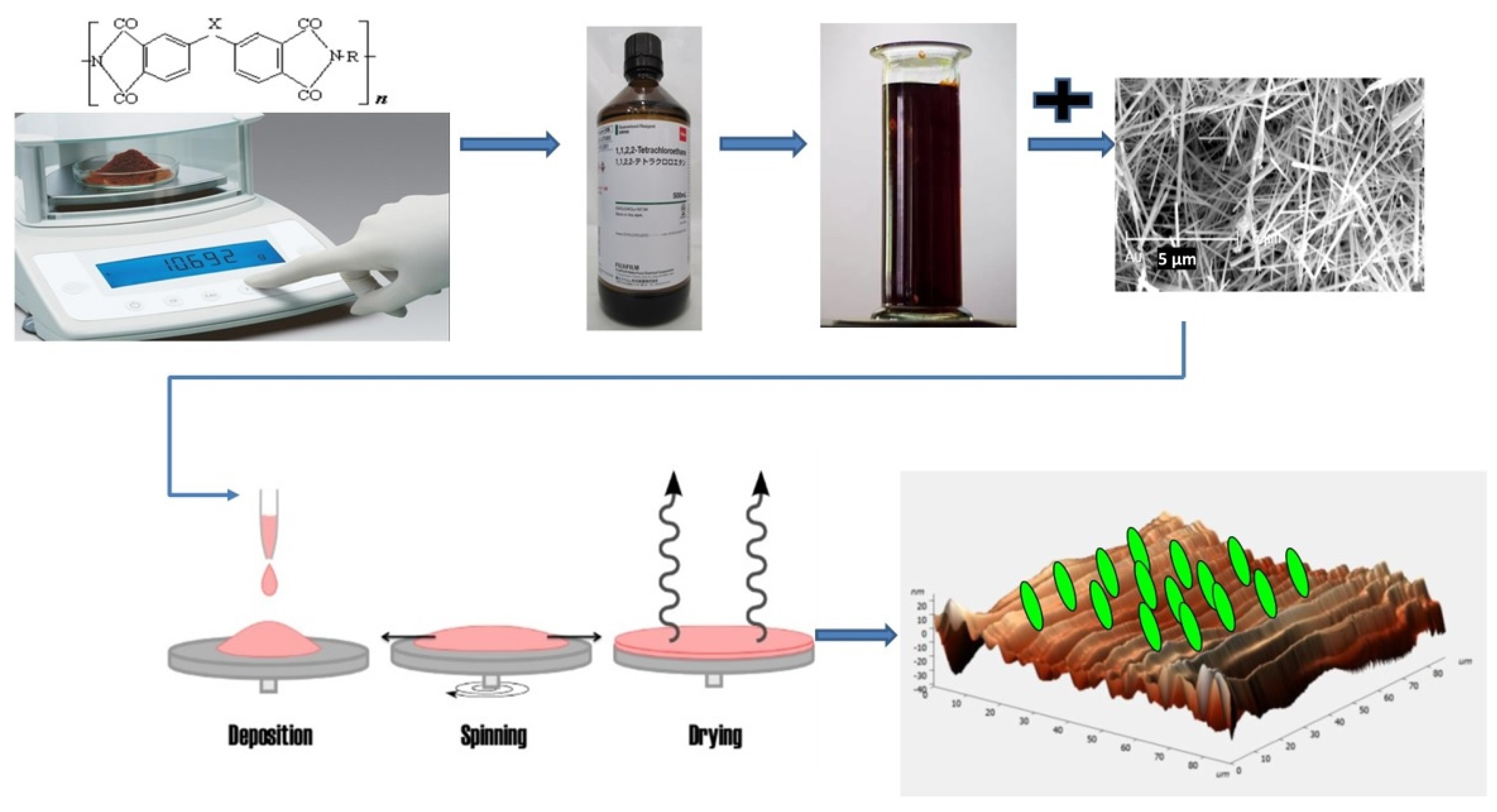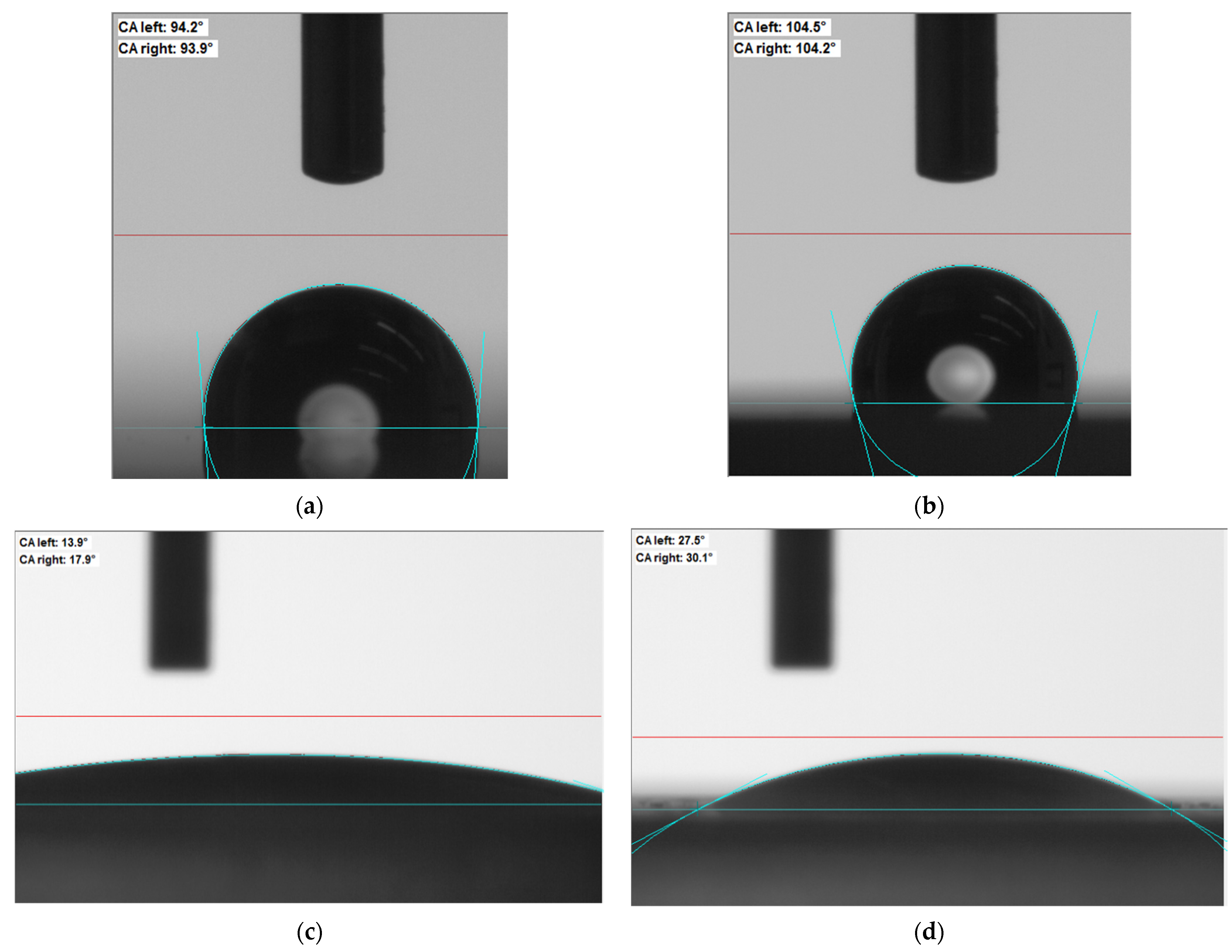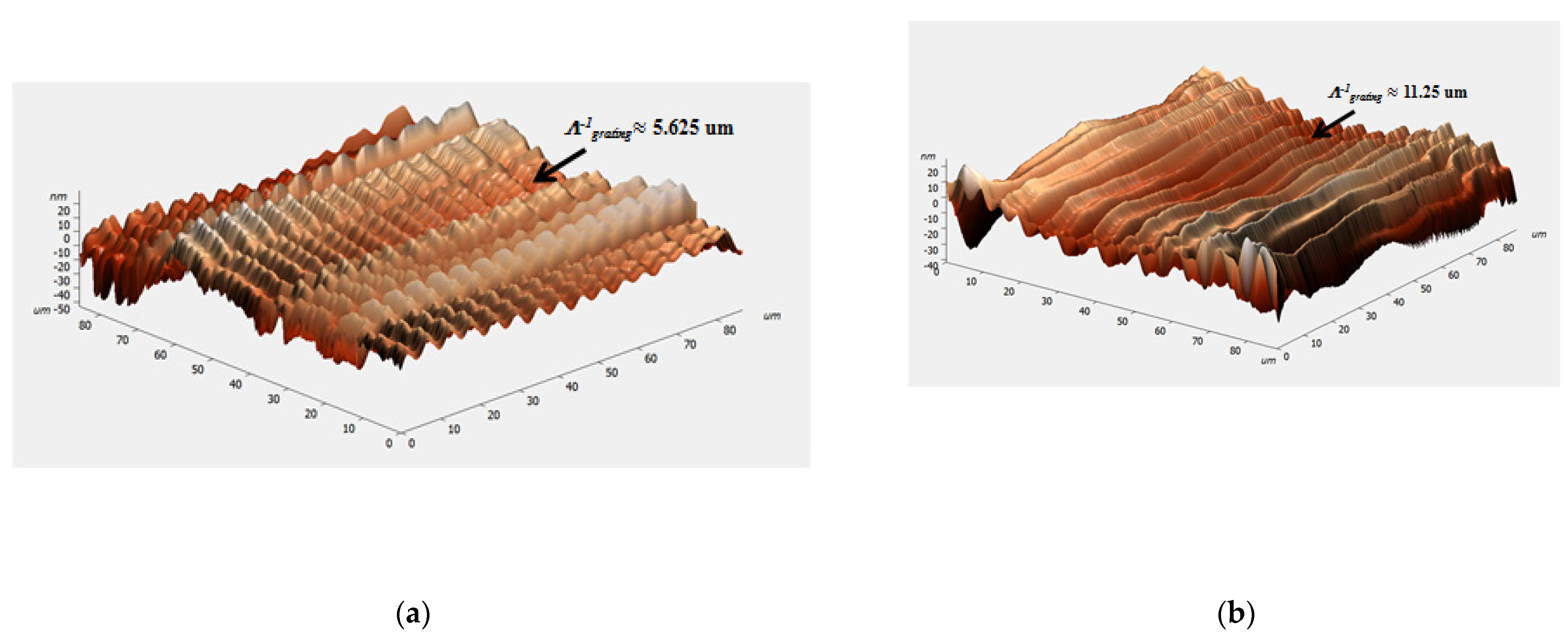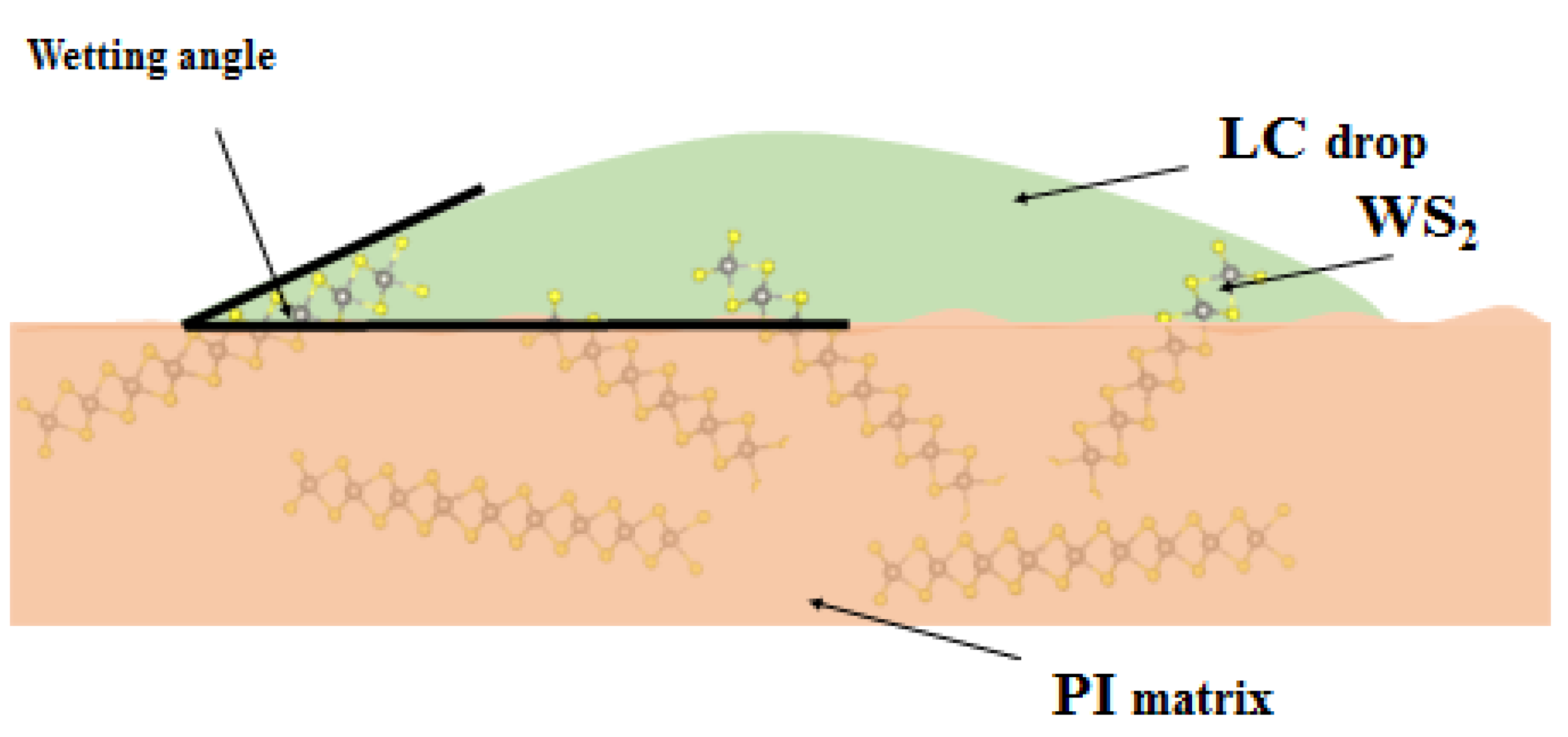Influence of Surface Relief on Orientation of Nematic Liquid Crystals: Polyimide Doped with WS2 Nanotubes
Abstract
1. Introduction
2. Materials and Methods
3. Results and Discussion
4. Conclusions
Author Contributions
Funding
Data Availability Statement
Acknowledgments
Conflicts of Interest
References
- Koch, C.C. Nanostructured Materials: Processing, Properties and Applications; Taylor & Francis: Raton, NM, USA, 2002; 176p, ISBN 0815514514/9780815514510. [Google Scholar]
- Lakhtakia, A. The Handbook of Nanotechnology. Nanometer Structures: Theory, Modeling, and Simulation; The International Society for Optical Engineering: Bellingham, DC, USA, 2004; Volume PM129, 576p, ISBN 9780819451866. [Google Scholar]
- Valiev, R.Z.; Zhilyaev, A.P.; Langdon, T.G. Bulk Nanostructured Materials: Fundamentals and Applications; 2013; 456p; ISBN 978-1-118-09540-9. Available online: Wiley.com (accessed on 24 February 2022).
- Kondawar, S.B.; Anwane, S.W.; Nandanwar, D.V.; Dhakate, S.R. Carbon Nanotubes Reinforced Conducting Polyaniline And Its derivative Poly(o-anisidine) Composites. Adv. Mater. Lett. 2013, 4, 35–38. [Google Scholar] [CrossRef]
- Mizuno, T.; Akasaka, Y.; Tachibana, H. Photovoltaic Properties of Solar Cells Based on Poly(methyl phenyl silane) and C60. Jpn. J. Appl. Phys. 2012, 51, 10NE31. [Google Scholar] [CrossRef]
- Romyen, N.; Thongyai, S.; Praserthdam, P.; Sotzing, G.A. Enhancement of poly(3,4-ethylenedioxy thiophene)/poly(styrene sulfonate) properties by poly(vinyl alcohol) and doping agent as conductive nano-thin film for electronic application. J. Mater. Sci. Mater. Electron. 2013, 24, 2897–2905. [Google Scholar] [CrossRef]
- Yang, L.; Li, M.; Zhang, Y.; Yi, K.; Ma, J.; Liu, Y. Synthesis and characterization of polypyrrole nanotubes/multi-walled carbon nanotubes composites with superior electrochemical performance. J. Mater. Sci. Mater. Electron. 2014, 25, 1047–1052. [Google Scholar] [CrossRef]
- Gusev, A.N.; Mazinov, A.S.; Tyutyunik, A.S.; Gurchenko, V.S. Spectral and conductive properties of film heterostructures based on fullerene-containing material and 4-methylphenylhydrazone N-isoamilisatine. Nanosystems 2019, 3, 331–336. [Google Scholar] [CrossRef]
- Hameed, T.A.; Mohamed, F.; Abdelghany, A.M.; Turky, G. Influence of SiO2 nanoparticles on morphology, optical, and conductivity properties of Poly (ethylene oxide). J. Mater. Sci: Mater. Electron. 2020, 31, 10422–10436. [Google Scholar] [CrossRef]
- Sang, G.; Xu, P.; Yan, T.; Murugadoss, V.; Naik, N.; Ding, Y.; Guo, Z. Interface engineered microcellular magnetic conductive polyurethane nanocomposite foams for electromagnetic interference shielding. Nano-Micro Lett. 2021, 13, 153. [Google Scholar] [CrossRef] [PubMed]
- Wahle, M.; Kasdorf, O.; Kitzerow, H.-S.; Liang, Y.; Feng, X.; Müllen, K. Electrooptic Switching in Graphene-Based Liquid Crystal Cells. Mol. Cryst. Liq. Cryst. 2011, 543, 187–953. [Google Scholar] [CrossRef]
- Zhou, L.; Saeed, M.H.; Zhang, L. Optical diffusers based on uniform nano-sized polymer balls/nematic liquid crystals composite films. Liq. Cryst. 2019, 47, 785–798. [Google Scholar] [CrossRef]
- Kamanina, N.V.; Zubtcova, Y.A.; Kukharchik, A.A.; Lazar, C.A.; Rau, I.; Lazǎr, C. Control of the IR-spectral shift via modification of the surface relief between the liquid crystal matrixes doped with the lanthanide nanoparticles and the solid substrate. Opt. Express 2016, 24, A270–A275. [Google Scholar] [CrossRef] [PubMed]
- Zhang, Y.; Li, K.; Su, F.; Cai, Z.; Liu, J.; Wu, X.; He, H.; Yin, Z.; Wang, L.; Wang, B.; et al. Electrically switchable photonic crystals based on liquid-crystal-infiltrated TiO2-inverse opals. Opt. Express 2019, 27, 15391–15398. [Google Scholar] [CrossRef] [PubMed]
- Sim, Y.; Choi, H. Creation of topological charges by the spontaneous symmetry breaking phase transition in azo dye-doped nematic liquid crystals. Opt. Mater. Express 2021, 12, 174. [Google Scholar] [CrossRef]
- Even, M.; Heinrich, B.; Guillon, D.; Guldi, D.M.; Prato, M.; Deschenaux, R. A Mixed Fullerene–Ferrocene Thermotropic Liquid Crystal: Synthesis, Liquid-Crystalline Properties, Supramolecular Organization and Photoinduced Electron Transfer. Chem. Eur. J. 2001, 7, 2595–2604. [Google Scholar] [CrossRef]
- Khoo, I.C. Holographic grating formation in dye- and fullerene C_60-doped nematic liquid-crystal film. Opt. Lett. 1995, 20, 2137–2139. [Google Scholar] [CrossRef] [PubMed]
- Ono, H.; Kawatsuki, N. Orientational Photorefractive Gratings Observed in Polymer Dispersed Liquid Crystals Doped with Fullerene. Jpn. J. Appl. Phys. 1997, 36, 6444–6448. Available online: https://iopscience.iop.org/article/10.1143/JJAP.36.6444/pdf (accessed on 24 February 2022). [CrossRef]
- Ono, H.; Saito, I.; Kawatsuki, N. Orientational photorefractive effects observed in poly(vinyl alcohol)/liquid crystal composites. Appl. Phys. B 1998, 66, 527–529. [Google Scholar] [CrossRef]
- Lee, W.; Chiu, C.-S. Observation of self-diffraction by gratings in nematic liquid crystals doped with carbon nanotubes. Opt. Lett. 2001, 26, 521–523. Available online: https://www.osapublishing.org/ol/abstract.cfm?URI=ol-26-8-521 (accessed on 24 February 2022). [CrossRef] [PubMed]
- Kamanina, N.V.; Sizov, V.N.; Staselko, D.I. Fullerene-doped polymer-dispersed liquid crystals: Holographic recording and optical limiting effect. Proc. SPIE 2001, 4347, 487–492. [Google Scholar] [CrossRef]
- Bukowczan, A.; Hebda, E.; Pielichowski, K. The influence of nanoparticles on phase formation and stability of liquid crystals and liquid crystalline polymers. J. Mol. Liq. 2021, 321, 114849. [Google Scholar] [CrossRef]
- Kamanina, N.V. Fullerene-dispersed nematic liquid crystal structures: Dynamic characteristics and self-organization processes. Phys.-Uspekhi 2005, 48, 419–427. [Google Scholar] [CrossRef]
- Kamanina, N.V. Photophysics of Fullerene-Doped Nanostructures: Optical Limiting, Hologram Recording and Switching of Laser Beam. Mater. Sci. Forum 2007, 555, 363–369. [Google Scholar] [CrossRef]
- Kamanina, N.V.; Serov, S.V.; Savinov, V.P.; Uskoković, D.P. Photorefractive and photoconductive features of the nanostructured materials. Int. J. Mod. Phys. B 2010, 24, 695–702. [Google Scholar] [CrossRef]
- Wang, Q.; Sun, R.; Tian, Y.; Huang, X. Effect of polymer network on orientation of liquid crystal molecules. Proc. SPIE 1998, 3319, 260–263. [Google Scholar] [CrossRef]
- Chigrinov, V.G.; Kozenkov, V.M.; Kwok, H.-S. E-Book: Photoalignment of Liquid Crystalline Materials: Physics and Applications; John Wiley & Sons, Ltd.: Chichester, UK, 2008; 248p, ISBN 9780470065396. Available online: https://www.wiley.com/en-sg/Photoalignment+of+Liquid+Crystalline+Materials%3A+Physics+and+Applications-p-9780470065396 (accessed on 24 February 2022).
- Chen, P.-J.; Chen, M.; Ni, S.-Y.; Chen, H.-S.; Lin, Y.-H. Influence of alignment layers on crystal growth of polymer-stabilized blue phase liquid crystals. Opt. Mater. Express 2016, 6, 1003–1010. [Google Scholar] [CrossRef]
- Kamanina, N.V.; Toikka, A.S.; Likhomanova, S.V.; Zubtsova, Y.A.; Lomova, L.S.; Kuzhakov, P.V. Correlation Between Concentration of Injected Nanoparticles and Surface Relief of Organic Matrices: A Promising Method for Liquid Crystal Molecules Orientation. Liq. Cryst. Appl. 2021, 21, 44–49. Available online: http://nano.ivanovo.ac.ru/journal/ru/articles/article.php?year=2021&issue=1&first_page=44 (accessed on 24 February 2022). [CrossRef]
- Kamanina, N.V.; Toikka, A.S.; Zvereva, G.N.; Kuzhakov, P.V.; Barnash, Y.V.; Tarasov, S.A. Surface Relief of Polyimide Thin-Film Orienting Materials for Liquid Crystalline Light Modulators. Liq. Cryst. Appl. 2021, 21, 47–52. Available online: http://nano.ivanovo.ac.ru/journal/ru/articles/article.php?year=2021&issue=4&first_page=47 (accessed on 24 February 2022). [CrossRef]
- Kamanina, N.V.; Zubtsova, Y.A.; Toikka, A.S.; Likhomanova, S.V.; Zak, A.; Tenne, R. Temporal Characteristics of Liquid Crystal Cell with WS2 Nanoparticles: Mesophase Sensitization and Relief Features. Liq. Cryst. Appl. 2020, 20, 34–40. Available online: http://nano.ivanovo.ac.ru/journal/ru/articles/article.php?year=2020&issue=1&first_page=34 (accessed on 24 February 2022). [CrossRef]
- Kamanina, N.V.; Zubtcova, Y.A.; Kuzhakov, P.V.; Zak, A.; Tenne, R. Correlations between spectral, time and orientation parameters of liquid crystal cells with WS2 nanoparticles. Liq. Cryst. Appl. 2020, 20, 41–48. Available online: http://nano.ivanovo.ac.ru/journal/ru/articles/article.php?year=2020&issue=3&first_page=41 (accessed on 24 February 2022). [CrossRef]
- Kamanina, N. Mechanisms of optical limiting in π-conjugated organic system: Fullerene-doped polyimide. Synth. Met. 2002, 127, 121–128. Available online: http://144.206.159.178/FT/983/52136/915061.pdf (accessed on 24 February 2022). [CrossRef]
- Kamanina, N.V.; Plekhanov, A.I. Optical limiting mechanisms in fullerene-containing π-conjugated organic materials: Polyimide and COANP. Proc. SPIE 2002, 4900, 61–71. [Google Scholar] [CrossRef]
- Tenne, R.; Margulis, L.; Genut, M.; Hodes, G. Polyhedral and cylindrical structures of tungsten disulphide. Nature 1992, 360, 444–446. Available online: https://www.nature.com/articles/360444a0#citeas (accessed on 24 February 2022). [CrossRef]
- Višić, B.; Panchakarla, L.S.; Tenne, R. Inorganic Nanotubes and Fullerene-like Nanoparticles at the Crossroads between Solid-State Chemistry and Nanotechnology. J. Am. Chem. Soc. 2017, 139, 12865–12878. [Google Scholar] [CrossRef] [PubMed]
- Yadgarov, L.; Višić, B.; Abir, T.; Tenne, R.; Polyakov, A.Y.; Levi, R.; Dolgova, T.V.; Zubyuk, V.V.; Fedyanin, A.A.; Goodilin, E.A.; et al. Strong light–matter interaction in tungsten disulfide nanotubes. Phys. Chem. Chem. Phys. 2018, 20, 20812–20820. [Google Scholar] [CrossRef] [PubMed]
- Kamanina, N.V. Surface Structuration and Its Advantages in Optoelectronics; Nova Science Publishers Inc.: New York, NY, USA, 2018; 105p, Available online: https://novapublishers.com/shop/surface-structuration-and-its-advantages-in-optoelectronics/ (accessed on 24 February 2022).
- Kamanina, N.V. Nanoparticles doping influence on the organics surface relief. J. Mol. Liq. 2019, 283, 65–68. [Google Scholar] [CrossRef]
- Kamanina, N.V. Liquid crystal materials orientation using new approach. Proc. CBU Int. Conf. Innov. Sci. Educ. 2019, 7, 933–937. [Google Scholar] [CrossRef][Green Version]





| Material Drop | Organic Film Material | Sensitizer Type | Sensitizer Content % | Film Thickness (μm) | α before Sensitization, ° | α after Sensitization, ° | Ref. |
|---|---|---|---|---|---|---|---|
| Water | PI | C70 | 0.5 | 3 | 72 | 89 | [38] |
| Water | PI | C70 | 1.0 | 3 | 72–73 | 103 | [39] |
| Water | PI | WS2 | 0.1 | 3 | 94 | 104 | current |
| LC * | PI | WS2 | 0.1 | 3 | 16 | 29 | current |
| Water | PI | CNTs | 0.1 | ~3–4 | 75–79 | 101 | current |
| LC | PI | CNTs | 0.1 | ~3–4 | 30 | 34 | current |
| Water | PMPS ** | C60 | 0.83 | 4 | 75 | 81 | [40] |
| Water | PVA | C60 | 0.1 | 50 | 40 | 83 | [40] |
| Water | PVA | CNTs | 1 | 50 | 39–40 | 82 | [40] |
| Water | NPP | C60 | 1 | 3 | 97 | 102 | [40] |
| Water | PNP | C70 | 1 | 3 | 90–91 | 94 | [40] |
| Water | PBMA *** | C60 | 0.34 | 2.5 | 54 | 61 | [40] |
| Surface Type | Root-Mean Square Roughness (Sq), nm | Average Roughness (Sa), nm | Maximum Area Peak Height, nm (Sp) | Maximum Area VALLEY Depth, nm (Sv) |
|---|---|---|---|---|
| Pure PI | 11.284 | 8.796 | 32.149 | 47.889 |
| PI + WS2 | 8.480 | 6.648 | 24.880 | 41.674 |
Publisher’s Note: MDPI stays neutral with regard to jurisdictional claims in published maps and institutional affiliations. |
© 2022 by the authors. Licensee MDPI, Basel, Switzerland. This article is an open access article distributed under the terms and conditions of the Creative Commons Attribution (CC BY) license (https://creativecommons.org/licenses/by/4.0/).
Share and Cite
Kamanina, N.; Toikka, A.; Barnash, Y.; Zak, A.; Tenne, R. Influence of Surface Relief on Orientation of Nematic Liquid Crystals: Polyimide Doped with WS2 Nanotubes. Crystals 2022, 12, 391. https://doi.org/10.3390/cryst12030391
Kamanina N, Toikka A, Barnash Y, Zak A, Tenne R. Influence of Surface Relief on Orientation of Nematic Liquid Crystals: Polyimide Doped with WS2 Nanotubes. Crystals. 2022; 12(3):391. https://doi.org/10.3390/cryst12030391
Chicago/Turabian StyleKamanina, Natalia, Andrey Toikka, Yaroslav Barnash, Alla Zak, and Reshef Tenne. 2022. "Influence of Surface Relief on Orientation of Nematic Liquid Crystals: Polyimide Doped with WS2 Nanotubes" Crystals 12, no. 3: 391. https://doi.org/10.3390/cryst12030391
APA StyleKamanina, N., Toikka, A., Barnash, Y., Zak, A., & Tenne, R. (2022). Influence of Surface Relief on Orientation of Nematic Liquid Crystals: Polyimide Doped with WS2 Nanotubes. Crystals, 12(3), 391. https://doi.org/10.3390/cryst12030391









